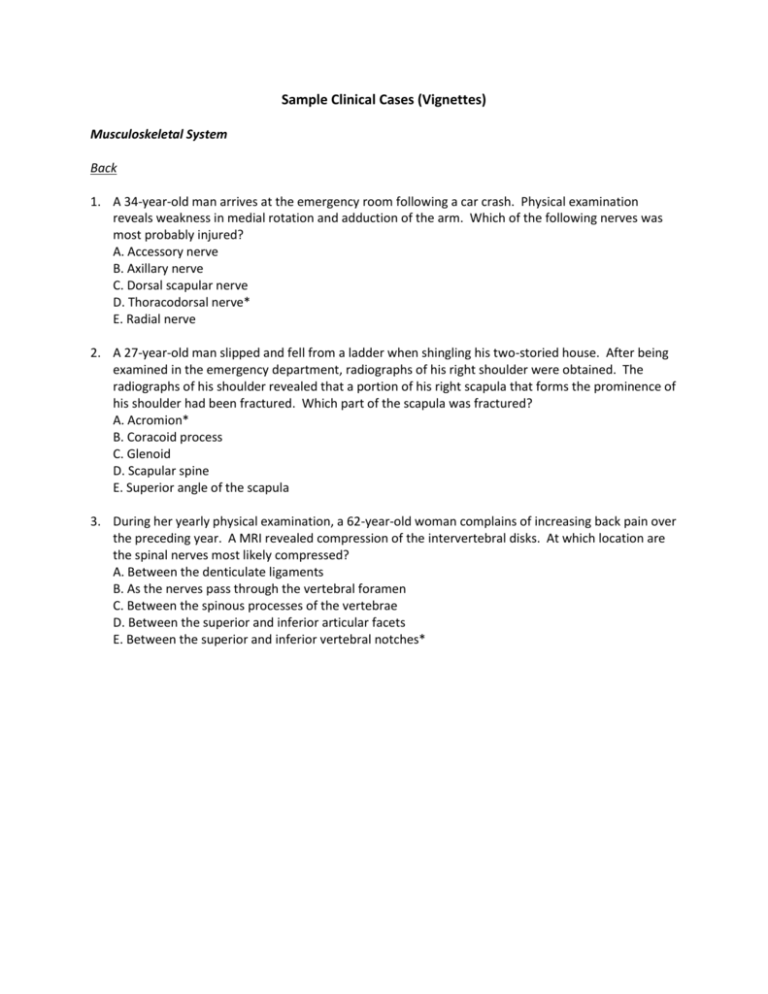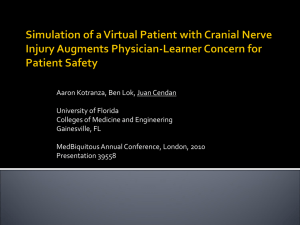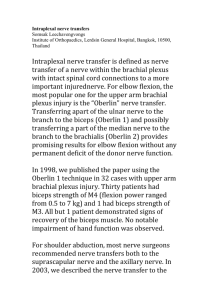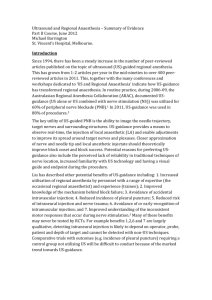Sample Clinical Cases (Vignettes) Musculoskeletal System Back 1
advertisement

Sample Clinical Cases (Vignettes) Musculoskeletal System Back 1. A 34-year-old man arrives at the emergency room following a car crash. Physical examination reveals weakness in medial rotation and adduction of the arm. Which of the following nerves was most probably injured? A. Accessory nerve B. Axillary nerve C. Dorsal scapular nerve D. Thoracodorsal nerve* E. Radial nerve 2. A 27-year-old man slipped and fell from a ladder when shingling his two-storied house. After being examined in the emergency department, radiographs of his right shoulder were obtained. The radiographs of his shoulder revealed that a portion of his right scapula that forms the prominence of his shoulder had been fractured. Which part of the scapula was fractured? A. Acromion* B. Coracoid process C. Glenoid D. Scapular spine E. Superior angle of the scapula 3. During her yearly physical examination, a 62-year-old woman complains of increasing back pain over the preceding year. A MRI revealed compression of the intervertebral disks. At which location are the spinal nerves most likely compressed? A. Between the denticulate ligaments B. As the nerves pass through the vertebral foramen C. Between the spinous processes of the vertebrae D. Between the superior and inferior articular facets E. Between the superior and inferior vertebral notches* Upper Extremity 1. A 29-year-old male, right-handed house painter visits his family physician because of pain in his right upper limb and slight tingling and numbness in all of his digits, but especially in the fourth and fifth digits when he reaches high over his head to paint. Radiographic studies reveal the presence of a cervical rib and accessory scalene musculature. Which of the following structures is most likely compressed when he reaches high to paint? A. Axillary artery B. Brachiocephalic artery and the superior trunk of the brachial plexus C. Lower trunk of the brachial plexus* D. Subclavian artery E. Superior trunk of the brachial plexus 2. A 44-year-old man is admitted to the hospital after a bar fight in which his right arm was severely injured. Radiographic examination of the arm reveals an oblique fracture of the humerus. Physical examination of the patient revealed he was unable to extend his forearm. The damaged nerve was composed of nerve fibers from what spinal cord segments? A. C5,C6 B. C5, C6, C7 C. C5, C6, C7, C8, T1* D. C7, C8, T1 E. C8, T1 3. A 32-year-old woman complains of pain in her right wrist after falling on some rocks when climbing up from a river bed. Radiographic studies indicate an anterior dislocation of a carpal bone in the proximal row. Which of the following bones is most commonly dislocated? A. Capitate B. Hamate C. Lunate* D. Triquetrum E. Scaphoid 4. A 35-year-old woman is brought to the emergency room following a car accident. Physical examination reveals severe pain in the flexor muscles of the forearm; fixed flexion position of the fingers; and swelling, cyanosis, and anesthesia of the fingers. Which of the following is the most likely diagnosis? A. Bennett’s fracture B. Boxer’s fracture C. Colle’s fracture D. Scaphoid fracture E. Volkmann’s ischemic contracture* Nervous System 1. A 52-year-old man was admitted to the neurosurgical unit for a scheduled removal of a tumor in the left jugular canal. Postoperatively, the patient had no gag reflex when the left pharyngeal wall was stimulated, although the pharynx moved upward and the gag reflex resulted when the right pharyngeal wall was stimulated. The uvula was deviated toward the right and the left vocal cord had drifted toward the midline. Which of the following structures contain the nerve cell bodies for the motor supply of the paralyzed muscles? A. Ambiguus nucleus* B. Dorsal motor nucleus of the vagus nerve C. Solitary nucleus D. Superior or inferior ganglia of the vagus nerve E. Trigeminal motor nucleus 2. A 45-year-old female patient visits her family physician because of severe headaches. A CT scan of the head reveals a tumor in the left infratemporal fossa. Physical examination reveals loss of general sensation on the left side of the tongue, but taste and salivation on the left are intact. Which of the following nerves is most likely affected by the tumor? A. Chorda tympani B. Glossopharyngeal nerve C. Inferior alveolar nerve D. Lesser petrosal nerve E. Lingual nerve proximal to its junction with the chorda tympani* 3. A 68-year-old male patient visits his family physician because of progressive problems in walking and a worsening lower back pain bilaterally that was not relieved following pain medications. An MRI scan of the lower back and pelvis revealed no abnormalities. Additional physical examination, including a full neurological examination, revealed papilledema of the optic disc. An MRI of the head revealed a meningoma of the falx cerebri. What area of the cerebrum was responsible for the difficulty with walking and the perception of lower back pain bilaterally? A. Calcarine cortex B. Insular cortex C. Paracentral lobule* D. Pre- and post-central gyri near the lateral fissure E. Transverse temporal gyri









